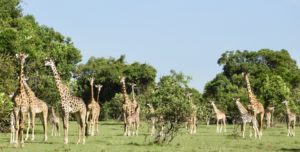
Six feet tall and adorable, baby giraffes are surprisingly common on Maasai lands at Oloirien Group Ranch in western Kenya. Since 2014, Maasai Morans Conservation and Walking Safaris (MMCWS) and Life Net Nature (USA)have conducted giraffe surveys at Oloirien on the Siria Plateau above the famous Masai Mara. Teams take photographs to identify and monitor individual giraffes.
Like fingerprints, coat patterns of giraffe are unique. Using pattern recognition software, Dr. Petra Campbell has identified more than 250 different giraffes frequenting the 16 square-kilometer study area at Oloirien. Photo analyses and modeling found that giraffes here have better survival than in most East African protected areas where lions are protected. At Oloirien, lions are either removed or euthanized to prevent harm to people and livestock. Lions prey on newborn giraffes, so it makes sense that mother giraffes move up to the Siria plateau to give birth and raise their young in nursery groups. Calf survival and proportions of newborn calves was much higher at Oloirien than in reserves like the Mara Triangle Conservancy where lions are protected. Read the scientific paper about it HERE.
However, for giraffe, all is not well on the plateau, and this special giraffe nursery area faces many threats. In 2019, Maasai at Oloirien privatized their communal lands. Several giraffe died when they became entangled in electric fencing defining new property boundaries. Farmers that rent land from Maasai speared and snare giraffes that are attracted to crops. Even tourism may be a problem as new developments block pathways traditionally used by giraffe to access the plateau.
Ultimately, giraffe conservation at Oloirien is in the hands of local Maasai landowners. Fortunately, around 100 Maasai landowners have formed a land conservancy with less fencing and more tolerance for wildlife on their properties. Currently, Life Net Nature provides secondary school scholarships for some of these families to further encourage conservation for wildlife.
You can help save baby giraffe and their nursery habitats by donating to Life Net Nature. Maasai children and young giraffe are the winners in this dynamic community-based effort.
Donate HERE
